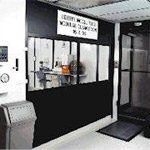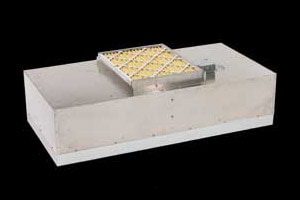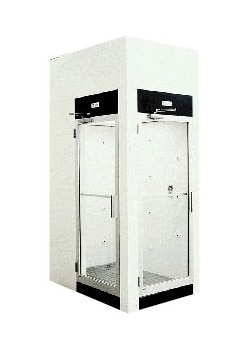Air Shower Newsletter
(Click on thumbnail to enlarge)
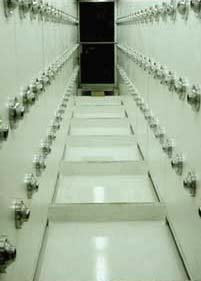
Air Showers – Are they worth the cost?
Do they really reduce contamination? Can they be cost justified?
The efficacy of air showers in the contamination control process has been a source of debate for several years.
Tests have been conducted which prove the effectiveness of air showers. The tests do show that an air shower does reduce particulate. For the most part, reduction in particulate matter is dependent upon the particle size, the type of garment worn, the cycle time, and directly relates to the air shower design and how it is used and maintained.
Does the use of an air shower justify its cost?
As a percentage of the total cost of the modern cleanroom, the cost of an air shower is virtually insignificant. In any application where contamination is critically important-such as life science, biomedical, pharmaceutical, parenteral drug, microelectronics, aerospace and precision manufacturing-air showers should be considered essential equipment.
If its use could eliminate contamination of one expensive batch of pharmaceutical chemicals or the rejection of one semiconductor wafer, for example, it is money well spent. Perhaps millions of dollars could be saved.
In addition, from a psychological point of view, having operating personnel pass through an air shower before entering the work area, reinforces the fact that cleanliness to the operation is essential. This, hopefully, reinforces the concept that protection of the product from personnel is a significant concern.
A brief history of the emergence of contamination control technology:
In today’s modern world of manufacturing and research and development, contamination control technology has become a necessary part of the manufacturing process. In fact, without it, many of the advances made in the last twenty years or so would not have been possible.
Contamination control technology is not confined to any one industry. Its practice transcends specific industries and is used, to some degree, in just about all manufacturing and research and development processes.
Without contamination control technology, the developing broad field of life sciences encompassing biotech, biomedical, pharmaceutical, parenteral drug, microelectronics, aerospace and precision manufacturing would not have been able to achieve some of the discoveries that have been made to date nor the discoveries yet to be made. While nanotechnology, a new emerging field of study in which is research done at the atomic or molecular level, could not exist without the advancements made in contamination control technology over the years.
Dealing with the issues of contamination control on a microscopic or smaller scale has led to the creation of the modern cleanroom and along with it, the air shower.
(Click on thumbnail to enlarge)
The primary focus of a cleanroom is to control the levels of contamination by creating a differential pressure between the cleanroom and the surrounding area and to filter the air entering the room to prevent the entry of unwanted particulate matter and to change the air in the room with an air-handling system to purge particulate matter created within the room. The cleanroom itself is constructed of materials that tend to resist particle generation, hence minimizing additional contamination. More sophisticated cleanrooms can also control temperature and humidity in the workspace.
In the conventional cleanroom, low velocity air enters from the ceiling plenum through perforated diffusers and carries out contamination through wall exhausts close to floor level. In the laminar flow clean room, air is introduced uniformly at low velocities into a space confined on four sides and through an opening equal to the cross sectional area of the confined space – a technique that stratifies the air and minimizes cross-stream contamination.
(Click on thumbnail to enlarge)
To keep this particulate matter from being recycled, both types of rooms use HEPA (high efficiency particulate air) filters. HEPA filters are manufactured from glass fiber, accordion-style pleated filters that can be up to 99.99% efficient in removing particles 0.3 microns and larger. For more stringent requirements, an ULPA (ultra low particulate air filter) filter may be used. An ULPA filter has the ability to remove a higher percentage of 0.3 micron particles than a HEPA filter.
Contamination vs. particulate matter:
So far in this discussion the terms “particulate matter” and “contamination” have been used interchangeably.
A contaminate is any foreign substance that will have a detrimental effect on whatever you are trying to accomplish. The most significant form of contamination in cleanrooms is submicroscopic matter that are distributed in the air in the form of fine particles or fibers or carried into the cleanroom and redeposited by workers.
To be technically correct, however, it should be pointed out that not all particulate matter is a contaminant. To be considered a contaminant, particulate matter must meet three criteria:
- It must be able to migrate to the vulnerable area, either by air currents, by fluids, or through transference from of personnel.
- It must be significant in number.
- It must have physical properties that can cause damage.
Sources of contamination are everywhere:
Just about all industrial activities produce contaminates. Operating personnel present the most significant source of contaminates – hair, skin, dandruff as well as oral and nasal emissions – to name a few. While contaminants can and do differ in terms of hardness, size, shape, translucency, color, etc., their size, in most cases, determines the degree of potential harm they can cause.
There is a very delicate balance between the contamination level, the number of personnel in a cleanroom and how they go about performing their assigned tasks. Some contamination is inevitable. In reality, there is very little you can do about this natural propensity to create contaminants except to instruct workers in correct cleanroom procedure and to deal with the unavoidable contamination as it arises. This is what cleanrooms have always done. You can certainly help matters by limiting the amount of contaminants that any specific individual brings in from the outside.
An air shower can be an integral part of the contamination control process because it can minimize the amount of contaminants brought into the cleanroom from the outside:
(Click on thumbnail to enlarge)
An air shower is nothing more than a device meant to limit the contamination brought into a controlled area such as a cleanroom. It works by moving air over the worker at a specific high velocity for a specified period of time. In a properly designed air shower, particles are driven off and away from the body and deposited on the upstream side of the HEPA or ULPA filters.
Air Showers have been used effectively in the cleanroom industry for over thirty-five (35) years and have been instrumental in reducing the level of contamination brought into the cleanroom.
Normally positioned between the cleanroom and the outside environment, an air shower is a chamber equipped with a blower unit, interlocking doors, HEPA filters and prefilters, a recirculating air system and multiple air nozzles. Various size nozzles are arranged on the walls and ceiling in a predetermined pattern for the most effective removal of loose particles, dust, or other particulate matter from the garments.
Filtered air is blown through the nozzles directly against the individual standing within the air shower, creating a flapping and shearing effect designed to remove loose contaminants prior to entering a change room, wash room, ante-room or cleanroom. The air is sucked taken from the chamber, stripped of its contaminants through the filtration system, and recycled back to the air shower to continue the cleaning job.
Today’s air shower is equipped with a powerful blower unit, solid state electrical control panels complete with safety monitors and emergency shut-down capabilities that may be activated from both the interior and exterior of the unit. Fluorescent lighting is flush ceiling mounted for maximum brightness.
Is there a difference between an Air Shower and an Air Lock?
An air shower is usually built into an air lock. It is important to remember that there is a big difference between the two.
An air lock is a room, corridor or some other space which separates the cleanroom from a less clean area. Generally, it has two (2) doors at opposite ends and is frequently designed with an electrical or mechanical interlock so that one door cannot be opened unless the other one is closed. Its purpose is to prevent the loss of valuable cleanroom air whenever a person leaves or enters the room and also to prevent contaminated air from entering the cleanroom when a door is opened. It also has the ability to conserve energy.
While an air shower can function in this capacity, it also has the additional advantage of being able to actively clean off contamination from the person entering the cleanroom with jets of filtered air coming out of the nozzles.
(Click on thumbnail to enlarge)

How does an air shower operate?
Typically an air shower can be operated in three (3) distinctly different ways depending on process requirements:
- One way
- Two way, one way
- Two way
One Way Operation:
- Exit door locked at rest, entrance door unlocked. When the user enters the air shower, the entrance door closes and locks; then the air shower cycle starts.
- At the end of the cycle, the entrance door stays locked and the exit door unlocks so that the user can leave.
- When the exit door is closed, it locks again and the entrance door unlocks.
- The air shower is now ready for use again.
Two way, one way operation:
- The air shower is used in both directions, but operates the air shower in only one direction.
- Only one door at a time can be opened.
- Both doors are unlocked at rest. The user enters the air shower via the entrance door. At the end of the air shower cycle, he leaves via the exit door.
- Or a user can enter the unit via the exit door once the exit door closes the user can immediately leave via the entrance door without activation the cycle. Both doors cannot be open at the same time.
Two way operation:
- In this mode, the cycle runs in both directions.
- Only one door at a time can be opened. The user can go in in either direction and the air shower will cycle.
(Click on thumbnail to enlarge)
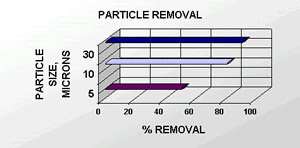
Test data has been obtained which prove that air showers are effective in reducing contamination brought into the cleanroom.
Data developed by a Japanese company several years ago indicates that, depending upon the particle size, particle removal can be up to 90%. The larger the particle, the higher the efficiency, as illustrated in the accompanying chart:
It is to be noted that proper operating protocol in using an air shower weighs greatly on its effectiveness. Training is of utmost importance to insure reduced contamination levels in cleanrooms and to ensure that the air shower is operating at maximum effectiveness. Proper protocol suggests personnel should be trained to rotate continuously 360 degrees, with hands on their heads as illustrated during the air shower cycle to insure contamination removal is as efficient as possible.
The Air Force has very exacting standards regarding acceptable levels of contamination while at the same time, has equally exacting standards when it comes to investing in equipment. In order to determine the efficacy of air showers the Air Force conducted tests of its own.
The test consisted of sending a team of twenty (20) operating personnel through two (2) air showers, one located before the entrance to the change room and the other before the entrance to the cleanroom itself with a cycle time of eight (8) seconds each. Operators were instructed to raise their arms and make a 360° turn. Prior to the entrance to the first air shower, outer garments are removed and stored. Once past the first air shower, the individual enters the change room where he puts on the cleanroom garments and goes through the second air shower, entering the cleanroom. After each test condition, the cleanroom was allowed to return to the normal contaminant level before a new test was begun and collections of samples were made.
- TEST 1
- BOTH AIR SHOWERS OFF
- 94,990 PARTICLES
- BASE READING
- TEST 2
- FIRST ON, SECOND OFF
- 52,920 PARTICLES
- 44%REDUCTION
- TEST 3
- SECOND ON, FIRST OFF
- 37,100 PARTICLES
- 61%REDUCTION
- TEST 4
- BOTH ON
- 19,290 PARTICLES
- 80%REDUCTION
All samples are taken from inside the cleanroom and 0.5 micron particles are measured
As can be seen, the level of contamination removal was at least 44% with at least one air shower in operation. With two (2) air showers in operation, contamination removal was 80%.
Further independent testing on the type of material workers are clothed in demonstrates that what the worker wears can make a significant difference in the amount of particulate removed by the air shower as indicated in the chart below:
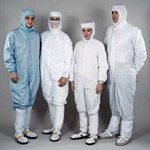
(Click on thumbnail to enlarge)
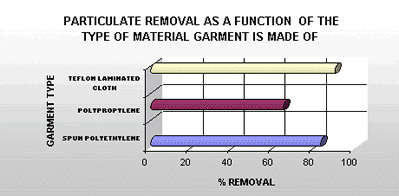
Today’s air showers can keep a significant amount of residual contamination from entering a cleanroom workplace as long as certain criteria are met:
- The air shower must be properly designed and sized to maintain effective and efficient operations.
- At a minimum, HEPA filters are 99.99% efficient at 0.3 microns or optional ULPA filter at 99.999% efficient at 0.12 microns.
- Sufficient “wash down time” – at least 45 seconds – must be allowed in the air shower.
- The air supplied to the shower must be finely filtered to prevent personnel from being impinged with contaminants during the actual cleaning cycle.
- A fixed nozzle pattern must be followed and the nozzles must be preset to direct air in a downward flow to produce shearing, wash down effect. It is essential to have a fluttering of garments strong enough to loosen dust.
- The garments themselves must be made of material such as Tyvek®, teflon, dacron or nylon that is less likely to shed than cloth; comfort and cost must not be the determining factor.
- The air shower must operate at a negative pressure. In other words, the pressure in the air shower must not exceed the pressure outside. The pressure must be less than the cleanroom side to prevent contaminates.
- Very importantly, personnel must act responsibly, i.e., when they stand off-center or crouch in a corner to avoid the air flow, they are defeating the whole purpose of the air shower. The individual must center himself in the shower and execute several complete 360° turns during the 45 second duration of the air shower, with hands positioned over the head.
- The individual must remain in the air shower for several moments as specified in the company’s protocol after it has stopped to allow enough “purge time,” or “dwell time” so that the particles may drift downward through the floor grate and are not drawn into the cleanroom by the movement of the individual as he leaves the air shower.
- Air showers, like cleanrooms or for that matter any process equipment, must be properly maintained in order to function properly. Lack of proper maintenance can become a major source of contamination.

